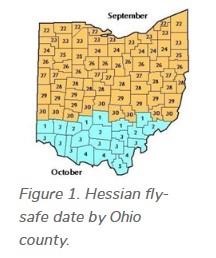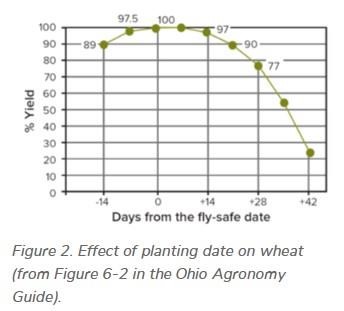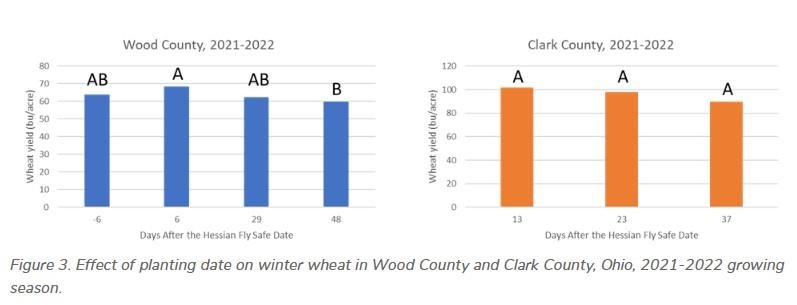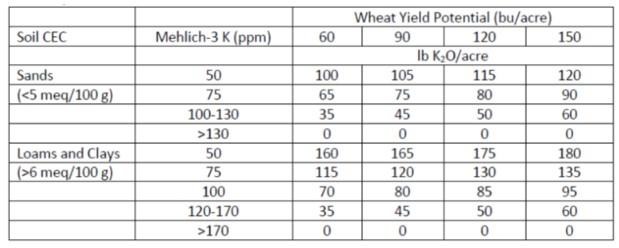By Laura Lindsey and Kelley Tilmon
Now that we’ve entered September, wheat planting is just around the corner. It can be tempting to plant wheat before your county’s Hessian fly-safe date (Figure 1); however, the best time to plant wheat is the 10-day period starting the day after the fly-safe date. Planting before the fly-safe date increases the risk of insect and disease problems including Hessian fly and aphids carrying Barley Yellow Dwarf Virus. Long-term averages shown in the Ohio Agronomy Guide indicate that yields are highest when wheat is planted within 10 days of the Fly Safe Date (Figure 2).


Right now, we still believe the best time to plant is within the 10-day period starting the day after the fly-safe date. But keep in mind that the Hessian fly-safe dates were calculated decades ago when average fall temperatures were cooler. Due to changes in fall weather, we are in the process of re-evaluating wheat planting dates with funding from Ohio Corn and Wheat. Last year, we conducted a wheat planting date study in Wood County and Clark County, Ohio. In Wood County, we planted 6 days prior to the fly-safe Date and 6, 29, and 48 days after the fly-safe date (Figure 3). Statistically, there was no difference in wheat yield for the first three planting dates (September 17 through October 22). In Clark County, we planted 13, 23, and 37 days after the fly-safe date (October 12-November 5), and grain yield was statistically the same across all three planting dates. We always need to be careful interpreting one year of data; however, our first-year data indicate that planting prior to the fly-safe date had no yield advantage. And, interestingly, planting 3-4 weeks after the fly-safe date had only a small effect on wheat yield. When freezing weather is delayed until November or early December, the impact of planting date is less. In an on-farm study in Fulton County (2019-2020 growing season), planting 11 days prior to the Fly Safe Date had no yield advantage over planting on the Fly Safe Date (https://kx-files-public.s3.us-east-2.amazonaws.com/efields-reports/2020_WheatPlantingDate_Fulton2.pdf).

Here are some other key management strategies for this fall:
- Select high-yielding varieties with high test weight, good straw strength, and adequate disease resistance. Do not jeopardize your investment by planting anything but the best yielding varieties that also have resistance to the important diseases in your area. Depending on your area of the state, you may need good resistance to powdery mildew, Stagonospora leaf blotch, and/or leaf rust. Avoid varieties with susceptibility to Fusarium head scab. Plant seed that has been properly cleaned to remove shriveled kernels and treated with a fungicide seed treatment to control seed-borne diseases. The 2022 Ohio Wheat Performance Test results can be found at: https://ohiocroptest.cfaes.osu.edu/wheattrials/
- Optimum seeding rates are between 1.2 and 1.6 million seeds/acre. For drills with 7.5-inch row spacing this is about 18 to 24 seeds per foot of row. When wheat is planted on time, actual seeding rate has little effect on yield, but high seeding rates (above 30 seeds per foot of row) increase lodging and risk of severe powdery mildew development next spring.
- Planting depth is critical for tiller development and winter survival. Plant seed 1.5 inches deep and make sure planting depth is uniform across the field. No-till wheat seeded into soybean stubble is ideal, but make sure the soybean residue is uniformly spread over the surface of the ground. Shallow planting is the main cause of low tiller numbers and poor winter survival due to heaving and freezing injury. Remember, you cannot compensate for a poor planting job by planting more seeds; it just costs more money.
- Follow the Tri-State Fertilizer Recommendations for Corn, Soybeans, Wheat, and Alfalfa (https://agcrops.osu.edu/FertilityResources/tri-state_info).
Apply 20 to 30 lb of actual nitrogen per acre at planting to promote fall tiller development. A soil test should be completed to determine phosphorus and potassium needs. Wheat requires more phosphorus than corn or soybean, and soil test levels should be maintained between 30-50 ppm (Mehlich-3 P) for optimum production (Table 1). Do not add any phosphorus if soil test levels are higher than 50 ppm.
Table 1. Wheat phosphorus recommendations from the Tri-State Fertilizer Recommendations for Corn, Soybeans, Wheat, and Alfalfa.

Soil potassium should be maintained at levels of 100-130 and 120-170 ppm (Mehlich-3 K) on sandy soils (CEC < 5 meq/100 g) and loam/clay soils (CEC > 6 meq/100 g), respectively. If potassium levels are low, apply K2O fertilizer at planting, depending on soil CEC and yield potential (Table 2).
Table 2. Wheat potassium recommendations from the Tri-State Fertilizer Recommendations for Corn, Soybeans, Wheat, and Alfalfa.

Soil pH should be between 6.3 and 7.0. In Ohio, limed soils usually have adequate calcium and magnesium.
Source : osu.edu